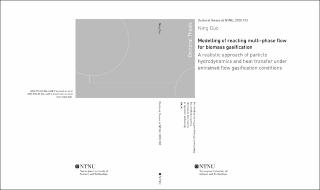| dc.contributor.advisor | Løvås, Terese | |
| dc.contributor.advisor | Li, Tian | |
| dc.contributor.author | Guo, Ning | |
| dc.date.accessioned | 2020-04-13T11:49:09Z | |
| dc.date.available | 2020-04-13T11:49:09Z | |
| dc.date.issued | 2020 | |
| dc.identifier.isbn | 978-82-326-4559-6 | |
| dc.identifier.issn | 1503-8181 | |
| dc.identifier.uri | https://hdl.handle.net/11250/2650837 | |
| dc.description.abstract | Entrained flow gasification of pulverized biomass is considered as one of the potential technology routes to produce syngas, which later can be used to produce second generation of biofuels via Fisher-Tropsch (FT) synthesis. To understand this process,modelling reacting multi-phase flows of biomass gasification is of interest. Computational fluid dynamics (CFD) simulations is a well-practiced tool to simulate such processes.
In many CFD simulations, biomass particles are assumed to be spherically shaped. This assumption is not in line with reality and could cause deviations from experiments, and its effects on simulation accuracy in terms of particle hydrodynamics and thermochemical conversions are not well investigated. As a first step to study this problem, a spheroidal shape assumption is made for pulverizedparticles and drag and torque models for spheroids are implemented into the open source CFD platform, OpenFOAM. It is then validated against various experiments and direct numerical simulation (DNS) data. This validated model is then applied to conduct non-reactive simulations in a configuration similar to entrained flow gasification of pulverized biomass. When compared with the traditional spherical method, this spheroid model predicted more diverse distributions of particle residence time and local concentrations, which may alter particle thermochemical conversion under reactive condition.
To investigate the aforementioned effects under reactive conditions, biomass particle gasification experiments are conducted in a laminar flat flame drop tube reactor to build the basis for reactive simulations validation. Particles of two different aspect ratios are gasified, both are tested at two available carrier gas flow rates. Particle velocity, size and volumetric information are obtained based on experiments. Delayed onset of dispersed soot incandescent matter is observed, probably due to heating rate caused by high flow rates of carrier gas and high particle volume fractions. Particle shape is seen to change in a heterogeneous way and influenced by particle heating rate, particle aspect ratio and carrier gas flow rate. Radial migration and rapid deceleration are also recorded. Particle alignment angles tend to be close to 0°.
Furthermore, a heat transfer model and a new set of devolatilization kinetic parameters suitable for fast heating rates, high temperatures and short residence times are further implemented in OpenFOAM. By comparing particle axial velocity, these model combinations are then validated against the drop tube experiments above under reactive conditions. Simulation results also point out that the radial migration and rapid deceleration of particles are very likely to be caused by fast release of volatiles, and particle alignment angles are probably dependent on gas flow velocity gradients. With the validated model combinations, four cases with different shapes, hydrodynamics and heat transfer approaches are configured to execute reactive simulations of conditions similar to entrained flow gasification of pulverized biomass,and their results are thereafter compared. Differences in particle velocity and conversion histories can be clearly observed. The Kishore-Gu model favors particle heat transfer and benefits drying and devolatilization greatly. However, the sphere and simplified non-sphere model predict 61% and 43% longer residence time than the spheroidal ones respectively, which helps slow processes like char conversion. These effects are somewhat contradicting what one would expect, and further investigation with more comprehensive and realistic operating conditions are recommended. | |
| dc.language.iso | eng | en_US |
| dc.publisher | NTNU | en_US |
| dc.relation.ispartofseries | Doctoral theses at NTNU;2020:103 | |
| dc.relation.haspart | Paper 1:
Guo, Ning; Li, Tian; Zhao, Lihao; Løvås, Terese. Eulerian-Lagrangian simulation of pulverized biomass jet using spheroidal particle approximation Fuel, Volume 239, 1 March 2019, Pages 636-651
https://doi.org/10.1016/j.fuel.2018.10.137 | en_US |
| dc.relation.haspart | Paper 2:
Llamas, Ángel David García; Guo, Ning; Li, Tian; Gebart, Rikard; Løvås, Terese;
Umeki, Kentaro.
Particle morphology, orientation and volume fraction of biomass particles with different aspect ratio in a jet flow during devolatilization
© 2020. This manuscript version is made available under the CC-BY-NC-ND 4.0 license http://creativecommons.org/licenses/by-nc-nd/4.0/ | en_US |
| dc.relation.haspart | Paper 3:
Guo, Ning; García Llamas, Ángel David; Li, Tian; Umeki, Kentaro; Gebart, Rikard; Løvås, Terese.
Computational fluid dynamic simulations of thermochemical conversion of pulverized biomass in a dilute flow using spheroidal approximation.
The final published version is available in
Fuel, Volume 271, 1 July 2020, 117495
https://doi.org/10.1016/j.fuel.2020.117495
(CC BY 4.0) | en_US |
| dc.title | Modelling of reacting multi-phase flow for biomass gasification | en_US |
| dc.type | Doctoral thesis | en_US |
| dc.subject.nsi | VDP::Technology: 500::Environmental engineering: 610 | en_US |
